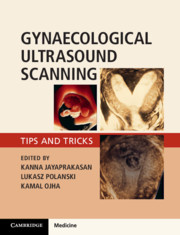Book contents
- Gynaecological Ultrasound Scanning
- Gynaecological Ultrasound Scanning
- Copyright page
- Contents
- Contributors
- Chapter 1 Get to Know Your Machine and Scanning Environment
- Chapter 2 Baseline Sonographic Assessment of the Female Pelvis
- Chapter 3 Difficult Gynaecological Ultrasound Examination
- Chapter 4 Sonographic Assessment of Uterine Fibroids and Adenomyosis
- Chapter 5 Sonographic Assessment of Congenital Uterine Anomalies
- Chapter 6 Sonographic Assessment of Endometrial Pathology
- Chapter 7 Sonographic Assessment of Polycystic Ovaries
- Chapter 8 Sonographic Assessment of Ovarian Cysts and Masses
- Chapter 9 Sonographic Assessment of Pelvic Endometriosis
- Chapter 10 Sonographic Assessment of Fallopian Tubes and Tubal Pathologies
- Chapter 11 Role of Ultrasound in Assisted Reproductive Treatment
- Chapter 12 Operative Ultrasound in Gynaecology
- Chapter 13 Sonographic Assessment of Complications Related to Assisted Reproductive Techniques
- Chapter 14 Sonographic Assessment of Early Pregnancy
- Chapter 15 Tips and Tricks when Using Ultrasound in a Contraception Clinic
- Chapter 16 Doppler Ultrasound in Gynaecology
- Index
- References
Chapter 12 - Operative Ultrasound in Gynaecology
Published online by Cambridge University Press: 28 February 2020
- Gynaecological Ultrasound Scanning
- Gynaecological Ultrasound Scanning
- Copyright page
- Contents
- Contributors
- Chapter 1 Get to Know Your Machine and Scanning Environment
- Chapter 2 Baseline Sonographic Assessment of the Female Pelvis
- Chapter 3 Difficult Gynaecological Ultrasound Examination
- Chapter 4 Sonographic Assessment of Uterine Fibroids and Adenomyosis
- Chapter 5 Sonographic Assessment of Congenital Uterine Anomalies
- Chapter 6 Sonographic Assessment of Endometrial Pathology
- Chapter 7 Sonographic Assessment of Polycystic Ovaries
- Chapter 8 Sonographic Assessment of Ovarian Cysts and Masses
- Chapter 9 Sonographic Assessment of Pelvic Endometriosis
- Chapter 10 Sonographic Assessment of Fallopian Tubes and Tubal Pathologies
- Chapter 11 Role of Ultrasound in Assisted Reproductive Treatment
- Chapter 12 Operative Ultrasound in Gynaecology
- Chapter 13 Sonographic Assessment of Complications Related to Assisted Reproductive Techniques
- Chapter 14 Sonographic Assessment of Early Pregnancy
- Chapter 15 Tips and Tricks when Using Ultrasound in a Contraception Clinic
- Chapter 16 Doppler Ultrasound in Gynaecology
- Index
- References
Summary
Ultrasound has been used as a guide during gynaecological operative procedures, in addition to the role in diagnostic testing. In the field of gynaecology, some of the interventions, especially intrauterine procedures, are carried out without imaging guidance or with limited view, and are performed based on clinical skills and experience alone. Operative ultrasound provides concurrent visualization of the structures and contents and, therefore, has the potential to improve efficacy and safety of the operative interventions.
- Type
- Chapter
- Information
- Gynaecological Ultrasound ScanningTips and Tricks, pp. 168 - 175Publisher: Cambridge University PressPrint publication year: 2020



